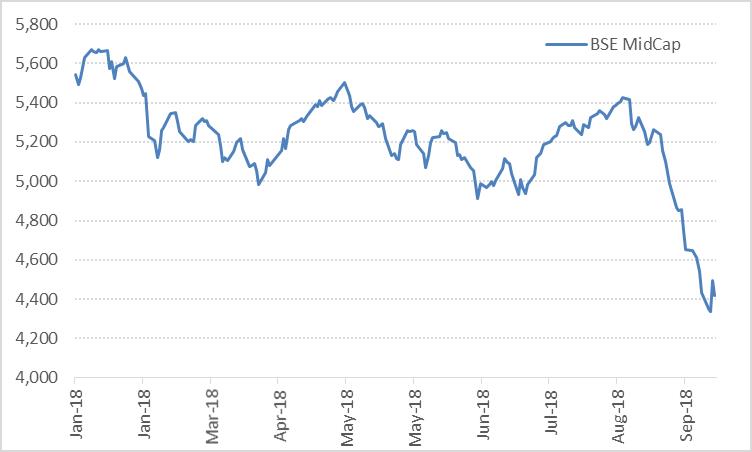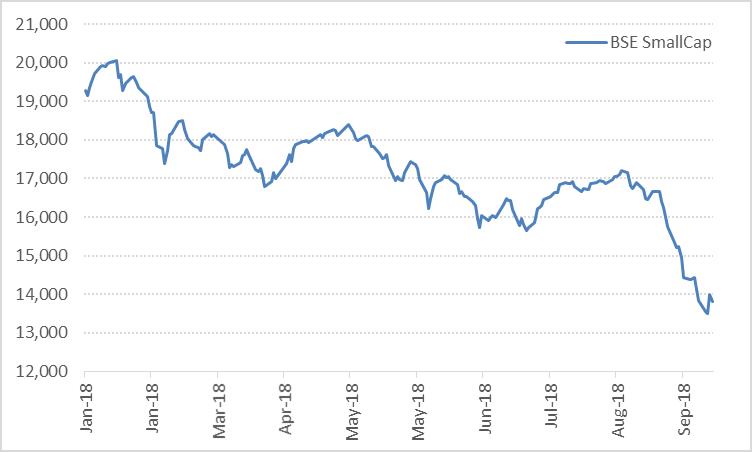The Indian equity market has been witnessing intense turbulence of late. Several heavyweights of the benchmark index have descended as evaporating liquidity, poor results, and governance issues have emerged. The mid and small-cap space, in particular, has been hammered.
The BSE 150 MidCap is down a little over 22% from its January high, while BSE SmallCap index has declined 31% from its 2018 peak. Many individual stocks have nosedived in the range of 40%-70%.
Graph 1: BSE 150 MidCap: Faltering on performance

Date as on October 11, 2018
(Data source: BSE)
So, is it the right time to reconsider investing in mid and small-cap mutual funds?
If yes, how does one construct a portfolio?
Despite deeper corrections in the mid and small-cap indices, valuations at the index level still look expensive. The BSE MidCap is trailing at a Price to Earnings (P/E) multiple of 30x, on trail earnings.
Graph 2: BSE Small-Cap Index: Will it bounce back?

Date as on October 11, 2018
(Data source: BSE)
On the other hand, the small-cap is at the trail P/E of 60x. However, a majority of companies constituting the index are losing money in their business.
Sounds scary, isn't it?
However, there's a silver lining.
After such massive price erosions, valuations of some companies have become relatively inexpensive compared to their peak valuations. If these companies post good results in the upcoming quarters, we could see stocks rebounding sharply from their current lows.
In other words, you have to be very selective about the companies you are investing in. And unless you have the expertise to select worthy mid-caps and small-caps on your own, you are likely to miss the opportunity in the present market correction.
Investing in mid and small-cap funds could prove to be a worthy option at this juncture, provided you possess a very high-risk appetite and an investment time horizon of at least 5-7 years.
What should your investment strategy be?
Instead of investing in a top-rated midcap or a small-cap fund, take a holistic view to your portfolio construction activity.
How much to invest in mid and small-cap funds i.e. their total composition to your overall equity mutual fund portfolio is the key.
At this juncture where there are several headwinds in play for the Indian equity market and there could some turbulence, PersonalFN recommends you to follow the 'Core and Satellite' investment approach.
What is Core and Satellite Approach?
The term 'Core' applies to the more stable, long-term holdings of the portfolio; while the term 'Satellite' applies to the strategic portion that would help push up the overall returns of the portfolio, across market conditions.
The 'Core and satellite' investing is a time-tested strategy to build your investment portfolio. For the mutual fund investors, the 'core portfolio' should consist of large-cap, multi-cap, and value funds, while the 'satellite portfolio' should include mid-cap and small-cap funds and the ones that follow an opportunities style.
PersonalFN believes, if you apply this approach to invest in equity oriented mutual funds, you can get the best of both worlds, i.e., short-term high-rewarding opportunities and long-term steady-return investing.
That's a good thing!
Why?
Simply because it works!
In PersonalFN's view, 60% of the portfolio should be in Core mutual funds and the balance 40% in Satellite mutual funds.
But what matters the most is the art of cleverly structuring the portfolio by assigning weights to each category of mutual funds and the schemes picked for the portfolio.
Moreover, with changes in market outlook, the allocation to each of the schemes, especially in the satellite portfolio, needs to change.
How can you make the most of 'Core and Satellite' approach?
Careful selection of mutual fund schemes is the key.
Watch this video to learn how to select equity mutual funds:
You can't invest blindly in any scheme that carries a five-star rating—be it a small and midcap fund or a large-cap or a value fund.
[Read: Why You Should Stop Looking At Mutual Fund Star Ratings Now ]
Selecting Core and Satellite schemes
The selection process must be purely based on thorough research and analysis. Your agent, neighbours, and colleagues are welcome to share their views but remember at the end of the day it's your money, not theirs. Moreover, investing is an individualistic exercise. The old adage, "one man's meat is another man's poison" applies even to the world of investing.
Before investing in a mutual fund:
-
Don't forget to clearly identify your financial goals and ensure your mutual fund investments are in-line with them.
-
Gauge the time horizon before the financial goals befall.
-
Based on your risk appetite, draw up a personalised asset allocation chart.
-
Only if you have a high-risk appetite and longer time horizon (at least 3-5 years) to fulfil your goals, invest more in equity-oriented mutual funds; otherwise, stick to fixed-income investments.
[Read: Why You Should Not Ignore Personalized Asset Allocation While Investing ]
Finally, when you invest in equity mutual fund schemes prefer the Direct Plan and make sure the schemes displayed consistently good performance track record across timeframes and market phases (bull and bear). Thus, ensure the schemes come from fund houses that sound investment processes and systems. Read about PersonalFN's research methodology here.
If you worried about the present extreme market volatility, Systematic Investment Plans (SIPs) would help you mitigate the risk while you build a portfolio based on the 'Core and Satellite' approach to investing.
Editor's note:
PersonalFN offers you a great opportunity a ready-made strategic portfolio based on the 'Core and Satellite' approach to investing. Here's PersonalFN's premium report: The Strategic Funds Portfolio For 2025 (2018 Edition).
If you're looking for "high investment gains at relatively moderate risk" this ready-made portfolio would be suitable for you
In this report, PersonalFN will provide you with a ready-made portfolio of its top equity mutual funds schemes for 2025 that have the ability to generate lucrative returns over the long term.
PersonalFN's "The Strategic Funds Portfolio for 2025" is geared to potentially multiply your wealth in the years to come. Subscribe now!

Happy Investing!
Add Comments